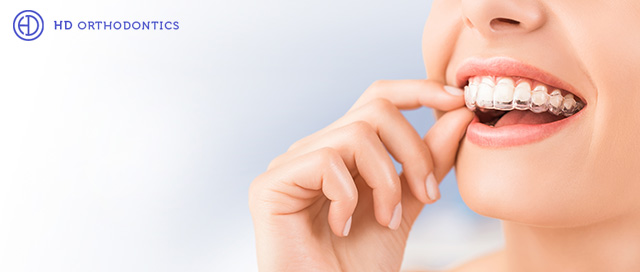Frequently Asked Questions About Invisalign: Everything You Need to Know
Frequently Asked Questions About Invisalign: Everything You Need to Know
Blog Article
Invisalign vs. Standard Braces: Which Alternative Is Right for You?
When taking into consideration orthodontic treatment, the choice in between Invisalign and standard dental braces offers numerous crucial elements that merit mindful examination. Invisalign uses a discreet choice with detachable aligners, while conventional braces supply a more noticeable yet efficient solution for extreme misalignment.
Overview of Therapy Options

In contrast, typical braces include steel brackets and cables that are adhered to the teeth. This method applies constant stress in time to attain alignment. While efficient for complicated orthodontic concerns, traditional braces need routine visits for adjustments and can position difficulties in keeping dental health due to the difficulty of cleaning around cords and braces.
Both options have their benefits, and the choice typically pivots on details oral problems, way of living choices, and person conformity. Inevitably, speaking with an orthodontic expert is important for figuring out one of the most ideal therapy strategy tailored to private requirements. Understanding the nuances of each option can substantially influence the general success of orthodontic therapy.
Aesthetic Factors To Consider
A substantial element affecting the option between Invisalign and typical braces is the visual charm each therapy uses. Invisalign aligners are crafted from clear plastic, making them virtually unseen when used.
On the other hand, standard dental braces include steel brackets and cords, which can be much more recognizable. While improvements in orthodontic technology have brought about the development of smaller sized braces and colored elastics, traditional braces still keep an even more conspicuous profile. For some individuals, the exposure of dental braces may hinder them from seeking required therapy.
Eventually, the choice in between Invisalign and typical dental braces might pivot on individual choices regarding looks. People that focus on discretion frequently lean towards Invisalign, while those who are less concerned concerning exposure might select traditional dental braces. Recognizing the aesthetic implications of each choice is critical for making a notified choice that aligns with one's way of life and choices.
Convenience and Convenience

In terms of convenience, Invisalign aligners are detachable, allowing people to appreciate their preferred foods without restriction and maintain ideal oral hygiene. Brushing and flossing are simplified, as the aligners can be secured throughout these routines, whereas standard dental braces require mindful maneuvering around braces and wires.
In contrast, typical dental braces demand routine modifications, making them much less practical for those with hectic schedules. In general, the comfort and ease of Invisalign make it an enticing choice for lots of people looking for orthodontic therapy.
Therapy Duration and Performance
While both Invisalign and standard dental braces are efficient in fixing oral misalignments, the duration of therapy can differ substantially between both choices. Generally, Invisalign treatment can take anywhere from 12 to 18 months, depending on the complexity of the situation. The clear aligners work by progressively changing teeth into their desired placements, and regular follow-ups with an orthodontist assistance guarantee progression stays on the right track.
In contrast, typical braces often need a longer commitment, usually varying from 18 months to three years. This results from their fixed nature and the use of braces and why not find out more wires, which can be much more reliable for intricate cases and extreme misalignments (Invisalign). The therapy efficiency of conventional braces is well-documented, as they permit precise changes and better control over tooth activity
Inevitably, the option between Invisalign and traditional dental braces might rest on both the anticipated therapy duration and the certain dental problems handy. Consulting with an orthodontist is important, as they can offer tailored referrals based upon private requirements, guaranteeing the chosen technique straightens with desired end results and durations.
Expense Comparison and Insurance Policy Choices
Expense plays a substantial function in the decision-making process for people thinking about orthodontic therapy, whether going with Invisalign or conventional braces. Usually, the price of Invisalign ranges from $3,000 to $8,000, while standard dental braces typically cost between $2,000 and $6,000. Aspects affecting these prices consist of the intricacy of the situation, the duration of therapy, and geographical place.
Lots of oral insurance policy strategies provide partial coverage for orthodontic treatments, yet the specifics can vary widely. Normally, typical dental braces may be much more often covered by insurance policy plans compared to Invisalign, which some insurance providers classify as a cosmetic procedure.
Furthermore, a number of orthodontic techniques provide adaptable layaway plan, making both therapy alternatives much more easily accessible. Patients need to inquire about prospective funding alternatives and discounts for in advance repayments. Assessing the total expense, consisting of insurance benefits and payment plans, is necessary for making an informed decision that aligns with both visual preferences and budget factors to consider.

Verdict
In recap, the selection between Invisalign and traditional braces depends upon multiple aspects, consisting of aesthetic preferences, convenience, treatment period, and price. Invisalign provides a very discreet, detachable option that helps with oral health and dietary versatility, while conventional braces might be better for complicated dental concerns and frequently come at a reduced cost factor. Eventually, examination with an orthodontist is necessary to examine private situations and figure out the most proper treatment choice for accomplishing ideal dental positioning.
When thinking about orthodontic treatment, the selection between Invisalign and typical dental braces provides visit this web-site a number of essential aspects that warrant cautious analysis.Comparing Invisalign and standard braces exposes unique treatment alternatives for orthodontic adjustment.While both Invisalign and typical dental braces are efficient in correcting oral misalignments, the period of official site therapy can vary substantially between the 2 options.Expense plays a substantial role in the decision-making procedure for people considering orthodontic treatment, whether choosing for Invisalign or conventional braces.In summary, the choice in between Invisalign and traditional braces pivots on several variables, including visual choices, convenience, treatment period, and cost.
Report this page